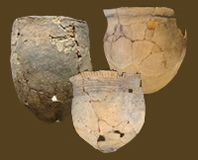Glossary
of Prehistoric Ceramic Terms
A B C D E F G H I J K L M N O P Q R S T U V W X Y Z
A
B
Base
The bottom portion of a vessel, that comes in contact with
the surface it rests on during normal use. Generally rounded
or pointed end of a cone. Some Early Woodland pottery
was made with flat bottoms.
Body
Clay or a mixture of clay and inclusions (temper)
that is suitable for forming vessels or that has been fired
into a vessel.
C
Castellation
An embellishment to the vessel rim producing a squared
rather than rounded vessel orifice (mouth).
Clay
Fine grained sediment, with a particle size of less than two-thousandths
of a millimeter. Clay has the property of plasticity
when wet.
Coil
Construction
Manufacturing technique involving the forming and joining
of narrow coils of clay to create the walls of a vessel.
Collar
A raised and extended mouths that begins at or just above
the point of maximum diameter of the vessel and does not significantly
reduce the opening relative to the body diameter
Cord-impressions
Decoration on pottery made by directly pressing cord against
the wet paste in horizontal, vertical, or diagonal bands and
cirss-cross patterns.
Cord-marking
Method of surface treatment common on many wares. Cord-marked
surfaces are often highly textured and marked by overlapping
rows of cord impressions. Cords were wrapped around a paddle,
which was used to create a surface bond between the clay coils
through malleation.
Cord-Wrapped
Stick
Decoration on pottery made by wrapping cordage around a stick
or dowel and then pressing it against the wet paste in horizontal,
vertical, or diagonal bands. This is also referred to as "cord-wrapped
dowel" or "pseudo-cord decorated."
D
E
F
Fabric-impressions
Like cord marking, fabric impressions were a surface treatment
created during manufacture. Sections of woven textiles,
such as mats or basketry were wrapped around paddles that
were used to create a surface bond between clay coils.
G
H
Hardness
The resistance of a material to surface damage, such as indentation,
scratching, abrasion, or crushing. The hardness test
used most commonly for archaeological pottery is the Moh’s Scale.
I
Incised
Method of decoration utilizing a sharp instrument such as
bone, shell, or stone to create a series of designs made of
rows or patterns of straight lines.
Inclusions
Naturally occurring particles in the clay, such as sand or
mineral bits.
J
K
L
Lip
The edge of the vessel mouth.
Lug Handles
Handles added just below the rim added for either utilitarian
purposes or decoration.
M
Moh’s Scale
A scale developed in the nineteenth century to test the hardness
of minerals, and contains a series of minerals ranging in
hardness from 1 (talc) to 10 (diamond). The mineral in the
scale is drawn across the test piece to determine which mineral
is sufficiently hard enough to mark the ceramic, thus
measuring scratch hardness.
N
Neck
Section of a vessel located between the body and the rim. It is characterized by a constriction and
change in orientation of vessel wall.
Net-impressions
Method of surface treatment created when knotted textiles,
such as net were used to malleate vessels during manufacture.
Notching
Method of decoration that consists of producing a series of
single lines on the rim or collar of the vessel.
O
Oxidizing Atmosphere
Oxygen-rich firing atmosphere.
P
Paddle Malleated
Finishing technique used to thin and shape a vessel by working
a wooden paddle against stone or ceramic anvil held
to the interior surface. Often the potter's hand was
used as an anvil. Various textiles were wrapped around
the paddle. see cord-marking, fabric-impressions,
and net- impressions.
Paste
Clay or mixture of clay and inclusions.
Punctations
Method of decoration used to produce small circular indentations
on the surface exterior.
Q
R
Reducing Atmosphere
Oxygen-poor firing atmosphere
Rim
Upper portion, including edge or lip, of vessel, at the mouth
(orifice).
S
Sherd
Fragment or piece of a broken vessel.
Smoothed
Surface treatment performed by rubbing the vessel walls with
a hard tool, such as a stone or potsherd, to produce a smooth
surface.
Shoulder
The upper part of the vessel between the maximum diameter
and the mouth
T
Temper
An agent purposely added to the paste in order to strengthen
the clay, and improve its workability. Particles
can range in size from very fine to several centimeters in
size. Materials used in this region include crushed
rock (i.e. geniss, quartz, hematite, and limestone), shell,
sand, or clay nodules.
Texture
Surface quality of the vessel.
Type
A group of wares that share the same surface treatment.
U
V
W
Ware
A group of pottery that share similar methods of manufacture, paste, temper, and vessel form. They are also
found in the same localities and are contemporaneous.
X
Y
Z |



